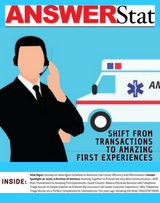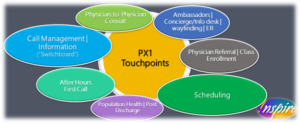Richard D. Stier, MBA
The consumer has spoken. Patient experience is now healthcare’s core differentiator. In a recent study of 2,000 participants across five countries in four continents, six out of ten consumers identified patient experience as extremely important to them as they defined it. [Jason A. Wolf, Ph.D. Patient Experience Journal, Volume 5, issue 1, 2018]
Extraordinary first experiences delivered through your organization’s contact center and across initial touchpoints can strengthen relationships and build trust. First patient experiences influence hospital preference [SHSMD, 2012], and impact subsequent patient volume and corresponding revenue.
A strategic opportunity is to navigate the shift from transactions to deliver amazing, differentiating first patient experiences. Four insights can enable that shift.
1. Discover Your First Experience Differentiator
Exactly what is it that makes your organization’s brand of first experiences truly distinctive from the perspective of those you serve? That is, what separates you from all others in your market?
Consider these related questions:
- Do your team members or associates feel personally supported and cared for? Are they eager to support and care for those they serve?
- What level of trust have you earned with providers? Are they strong advocates for your organization with their patients?
- Are callers to your contact center enjoying remarkable first connections? Are they so delighted that they become personal champions for your hospital or health network?
- What do patients say about their experiences at your organization when they’re talking with friends across social media?
- What is different about the first experiences you deliver? What’s better? What’s not so great?
- Are the first experiences you deliver consistent at all first touchpoints across your enterprise? Where are they best? Where do they need help?
Stakeholders move through an integration or an assimilation process as they experience healthcare organizations. For many, hospitals are scary places. People die in hospitals. Initial emotions can easily include fear and distrust.
Intention and focused effort are required to move many stakeholders beyond negative emotions and over the tipping point into positive responses such as safety, trust, and finally, to advocacy.
A foundation of trust with team members or associates, enables them, in turn, to express confidence in the organization when they interact with providers, callers, and patients. Each individual stakeholder is at a differing level of negative or positive response based on their own personal experiences.
Identify a baseline measurement of how each key stakeholder group perceives your organization. Understand which behaviors move that group from negative to positive responses. Listen deeply and in-person to the concerns of members of each stakeholder group to clarify how to differentiate your organization for them.
2. Audit First Experiences Across Initial Touchpoints
Once each stakeholder group’s requirements to earn trust are understood (vertical alignment), it is time to achieve consistent first patient experiences across initial touchpoints (horizontal alignment).
Perhaps your organization provides the initial touchpoints. Audit first patient experiences from the perspective of stakeholders who utilize each of these first touchpoints.
Partner with the team members or associates in each of these patient experience one (PX1) touchpoint areas to eliminate barriers to extraordinary first experiences. Outline desired themes for first conversations, not word-for-word scripts, which become mechanical, but conversation guides that are responsive to each individual and relevant to their needs.
Role-play initial conversations. Each team member should experience the role of the “patient.” Then they can share how the experience felt and suggest ways to enhance it. Include these role-plays as a permanent and recurring component of team member education.
3. Earn High Trust
Trust must be earned. It is evidenced by deep, focused listening, which seeks to serve each unique stakeholder. Every interaction is an opportunity for a memorable decisive moment.
Once established, elevate trust—even catapult it—by delivering unexpected “wows.” A wow is a surprising, proactive response to a stakeholder’s need.
Here are several examples of first experience wows suggested by Inspire Digital Solutions’ National Advisory Council:
- Deep, active listening to providers, callers, and patients by team associates
- First experience ambassadors who make personal visits to hospitalized frequent callers
- Personalized greeting and wayfinding by first experience ambassadors
- First experience ambassadors in the ER to align ER patients with in-network PCPs
- First experience ambassadors in the contact center calling an elderly patient’s caregiver, who might be a friend, neighbor, or relative to arrange transportation to follow-up appointments
- A dedicated triage phone line for team members and associates
4. Multiply Extreme Service to Accelerate Results
Addition is one associate earning trust with one stakeholder at a time. Multiplication is a team of equipped first experience leaders who train and empower their first experience ambassadors at each initial touchpoint across the enterprise. Contact Center: The first contact with your hospital or health network is usually with the contact center. That first connection may be on the phone or online.
Contact Center: The first contact with your hospital or health network is usually with the contact center. That first connection may be on the phone or online.
Establish behavior standards for that initial contact. As discussed above, outline key themes to guide the ideal first interaction. Listen deeply to acknowledge and validate both needs and feelings and to understand what the individual desires most—regardless if that desire is verbalized. Ask clarifying questions. Listen deeply.
Reduce or eliminate transferred calls. Make the contact center a single-stop solution. Once the initial request is addressed—whether online or on the phone—ask, “What can I do now to elevate your experience?”
First Touch Points: Establish behavior standards for delivering unexpected value. Work with first experience ambassadors to develop a unique list of wows at each initial touchpoint.
For example, first experience ambassadors for concierge, info desk, or wayfinding might include volunteer parking lot greeters who welcome patients with a smile, provide free parking vouchers, and escort them to their destination.
First experience ambassadors in the emergency department might carry a tablet loaded with contact center software, greet patients with kindness, and offer those without a primary care physician an immediate referral to an in-network provider for follow-on care.
First experience ambassadors in the contact center can reach out to a discharged elderly patient’s caregiver—such as a friend, relative, or neighbor—to arrange transportation to follow-up primary provider visits. This unexpected value reduces stress for the patient, increases kept appointment rates, and reduces avoidable readmissions.
A dedicated triage line in the contact center with a specific phone number expressly for team members or associates can speak volumes about the organization’s priority for caring for its own caregivers.
Hospital and Enterprise Integration: Preparation for service recovery should enable team members to seek first to understand, identify problem causes, discuss possible solutions, and suggest problem resolution.
First patient experience follow-up and follow-through should identify delays or roadblocks to appointments for needed services. Document complaints and compliments to enable both process improvement and recognition for excellence.
As extraordinary first experiences ripple across the enterprise, performance appraisals of all first experience ambassadors should include a review of their fluency with extreme service standards and provide financial incentives to recognize stellar performers.
Conclusion for Patient Experience
What is the monetary value of consistently delivered first patient experiences that positively distinguish your organization? Consider delighted patients who share their enthusiasm with friends across social platforms, higher satisfaction scores, and fewer avoidable readmissions. Also look at increased revenue and expanded market share. Is it one million dollars a year, ten million dollars a year, or more?
What is that value multiplied across your network? What is that value multiplied over five or ten years?
More fundamentally, what is the non-monetary value of an extraordinary first patient experience? This question goes to your reason for being, to your ethos, and your mission.
If your mission is satisfied by maximizing the bottom line over the immediate fiscal period, let’s be candid. In the near term, accomplishing transactions may be adequate.
However, if your commitment is to set a standard of excellence in quality care, then more is required. If your DNA is to transform the health of those you serve, more is needed.
We must navigate from success to significance. We must shift from processing transactions to deliver consistent, compassionate first experiences that earn trust. This is a hallmark of quality. This is access to optimal health.
Richard D. Stier, MBA is president of Inspire Digital Solutions. He brings three decades of results, improving first experiences as a senior executive, consultant, speaker, and author. He is honored to have led engagements resulting in more than 100 million dollars for clients. Inspire Digital Solutions partners with healthcare leaders to navigate the shift from transactions to deliver amazing first patient experiences.


